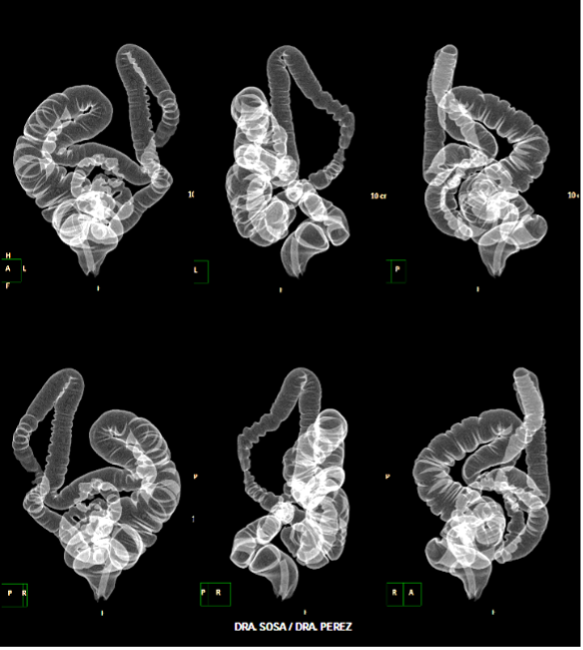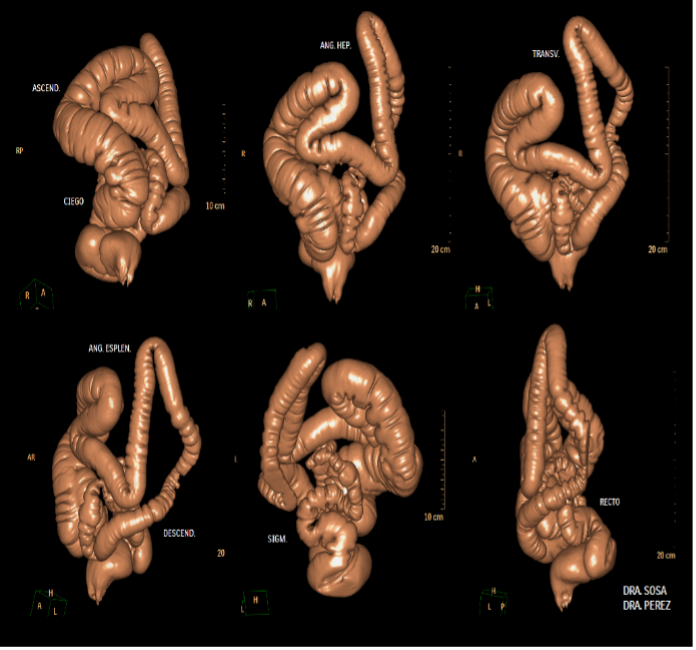Evaluación del Hábito Intestinal en una Población de Personal Hospitalario
Resumen
Introducción: La función evacuatoria y sus alteraciones constituyen un motivo de consulta muy frecuente. En Venezuela no disponemos de información para definir cuál es el patrón intestinal normal de nuestra población, ni de la frecuencia con que se presentan dichas alteraciones.
Objetivo: Evaluar el hábito intestinal en una población de personal hospitalario, entre 18 a 70 años, del Hospital Dr. Domingo Luciani entre abril - septiembre del 2008.
Método: Es un estudio descriptivo y transversal en el que participaron 507 trabajadores del hospital, a los cuales se les practicó una encuesta personalizada.
Resultados: Participaron 380 (75 %) mujeres y 127 (25 %) hombres con una edad 39,2 ±10 años. El 51,1% son universitarios. Menos de la mitad consumen medicamentos o sufren de enfermedades. La mayoría no fuma e ingiere menos de 2 litros de agua/día. El 73,4 % evacúa diariamente, una vez/día y en la mañana, con heces tipo 3. 12 (2,36 %) presentan constipación según ROMA III, edad 39 años, femenino, la mayoría son TSU y enfermeras (p=0,03) e ingieren menos de 2 litros de agua/día, consumen algunas veces frutas y cereales y muy poco realizan ejercicios. Los síntomas predominantes fueron: dispepsia, dolor y distensión abdominal, dolor al evacuar y sensación de evacuación incompleta. Todos evacuan heces tipo 1 y el 41,66 % empleo laxantes. El 50 % manifestó algún grado de alteración de su calidad de vida.
Conclusiones: El hábito intestinal de nuestra población se caracterizó por frecuencia evacuatoria diaria, una vez/día; heces tipo 3 y 4, sin sensación de evacuación incompleta, dolor o esfuerzo al evacuar.
Palabras clave
Referencias
Sandler RS, Drossman DA. Bowel habits in young adults not seeking health care. Dig Dis Sci 1987;32:841.
Lizarzábal M. La Gastroenterología del Nuevo Siglo en Venezuela. Diagnóstico situacional del primer quinquenio. Inves Clin 2007;48(2):47-58.
Drossman DA, Sandler RS, Mc Kee DC, Lovitz AJ. Bowel patterns among subjects not seeking health care. Gastroenterology 1982;83:529-34.
Cruz M, Clavo M, Baffi C, Díaz S, Fernández G, Suárez D, et al. Hábito Intestinal en Adolescentes del Servicio de Gastroenterología Dr. Alí Rivas Hospital Jesús Yerena de Lídice Mayo-Julio 2006. Gen 2007;61(2):233.
Di Palma J, Foxx OA, Bishop W and Fisher R. Case Studies in Constipation. A Continuing Medical Education Monograph; 2003.
Fernández X. Fisiopatología anorectal [tesis doctoral]. Barcelona: Universidad Autónoma de Barcelona; 2005.
Distrutti E, Salvidi B, Azpiroz F, Malagelada J. Rectal function and bowel habit in irritable bowel syndrome. Am J Gastroenterol 2004;99:131-37.
Duthie G, Gardiner A. Physiology of the gastrointestinal tract. 1ra ed. Whurr Publishers. Londres-England and Philadelphia-E.E.U.U;2004.
Varma KK, Stephens D. Neuromuscular reflexes of rectal continence. Aust. N.Z.J. Surg 1972;41:263-72.
Bartolo DC, Roe AM, Virjee J, Morensen NJ. Evacuation proctography in obstructed defecation and rectal intussusceptions. Br J Surg 1985;72 Suppl:111-116.
Müller S, Kamm M, Scarpignato C, Wald A. Myths and Misconceptions About Chronic Constipation. Am J Gastroenterol 2005;100:232-42.12.
Troglia O, Vega R. Estudio del hábito evacuatorio intestinal en dos poblaciones. Prensa med argent 1986;73(14):622-24.
Kojima M et al. Frecuencia de defecación y riesgo de cáncer colorrectal. Br J Cancer 2004;90(7):1397-1401.
Higgins PDR, Johanson JF. Epidemiology of constipation in North America: a systematic review. Am J Gastroenterol 2004; 99:750-59.
Sonnenberg A, Koch TR. Physician visits in the United Status for constipation. 1958 to 1986. Dic Dis Sci 1989;34:606-11.
Brian E, Brunton S. Partnering with gastroenterologists to evaluate patients with chronic constipation. Med Gen Med Gastroenterology 2005;7(2):19.
Talley NJ, OKeefe EA, Zinsmeister AR, Melton LJ. Prevalence of gastrointestinal symptoms in the elderly: A population-based study. Gastroenterology 1992;102:895.
Heaton KW, Cripps HA. Straining al stool and laxative taking in an English population. Dig Dis Sci 1993;38:1004.
Rao SS. Constipation: evaluation and treatment. Gastroenterol Clin North Am 2003;32:659-83.
Talley NJ, Jones M, Nuyts G, Dubois D. Risk factors for chronic constipation based on a general practice sample. Am J Gastroenterol 2003;98:1107-11.
Miguel M, Rodríguez JM, Ortiz H, Yárnoz MC, Marzo J, Artieda C. Prevalencia de las alteraciones de la función defecatoria en la población de Navarra. Anales Sis San Navarra 1999; 22:17-24.
Chen LY, Ho KY, Phua KH. Normal bowel habits and prevalence of functional bowel disorders in Singaporean adults-findings from a community based study in Bishan. Singapore Med J 2000; 41(6):255-58.
Zuckerman M, Guerra L, Drossman D, Foland J and Gregory G. Comparison of bowel patterns in hispanics and non-hispanic whites. Dig Dis Sci 1995;40(8):1763-9.
Curtin F, Morabia A, Bernstein M, Dederding JP. A population survey of bowel habits in urban Swiss men. European Journal of Public Health 1998;8(2):170-75.
Towers AL, Burgio KL, Locher JL, et al. Constipation in the elderly: Influence of dietary, psychological and physiological factors. J Am Geriatr Soc 1994; 42:701.
Preston DM, Lennard-Jones JE. Severe chronic constipation of young women: Idiopathic slow transit constipation. Gut 1986; 27:41.
Klauser AG, Peyerl C, Schindlbeck NE, Müller-Lissner SA. Nutrition and physical activity in chronic constipation. Eur J Gastroenterol Hepatol 1992;4:227.
Lennard-Jones JE. Estreñimiento. En: Feldman M, Friedman L, Sleisenger M. Enfermedades gastrointestinales y hepáticas: Fisiopatología, diagnóstico y tratamiento. 7a ed. Tomo 1. Editorial Médica Panamericana Argentina; 2004. p.192-225.
Maiza E. Constipación. Gastr Latinoam 1997;8:58-68.
Whitehead WE, Chaussade E, Corazziari E, et al. Report of an international workshop on management of constipation. Gastroenterol Int 1991;4:99-11.
Drossman DA. The functional gastrointestinal disorders and the Roma II process. Gut 1999;45(2):1-6.
Longstreth G, Thompson W, Chey W, Houghton L, Mearin F, and Spiller RC. Functional Bowel Disorders. Gastroenterology 2006;130:1480-91.
Zolezzi A. Las enfermedades funcionales gastrointestinales y Roma III. Rev gastroenterol Perú 2007;27:177-84.
Locke GR, Pembertom JH, Phillips SF. AGA technical review on constipation. American Gastroenterogical Association. Gastroenterology 2000;119:1766-78.
Cortesini C, Cianchi F, Infantino A, Lise M. Nitric oxide synthase and VIP distribution in enteric nervous system in idiopathic chronic constipation. Dig Dis Sci 1995;40:2450-55.
Lewis SJ, Heaton KW. Stool form scale as a useful guide to intestinal transit time. Scand J Gastroenterol 1997;32:920-24.
Drossman DA, Li Z, Andruzzi A, Temple R, Talley NJ, Thompson WC, et al. U.S. householder survey of functional gastrointestinal disorders. Prevalence, sociodemography, and health impact. Dig Dis Sci 1993;38:1569-80.
Heaton K, Radvan J, et al. Defecation frecuency and timing, and stool form in the general population: a prospective study. Gut 1992;33:818-24.
Won J, Park H, Lee O, Lak H, Chul Y, Soon CH, et al. A population-based study on bowel habits in a Korean community: Prevalence of functional constipation and self-reported constipation. Dig Dis Sci. 2006;51:1471-77.
Walter S, Hallb O, Gotthard R, Bergmark M, Sjdahl R. A population-based study on bowel habits in a Swedish community: Prevalence of faecal incontinence and constipation. Scandinavian Journal of Gastroenterology 2002;37(8):911-16.
Johanson J. Association of constipation with neurologic diseases: an epidemiologic study of the concordant ocurrence of diseases in the Medicare population. Dig Dis Sci 1992; 37:179.
López C, Tárraga L, Cerdán O, Ocaña L, Celada R, Solera A, et al. Estreñimiento en la población mayor de 50 años de la provincia de Albacete. Rev Esp Enferm Dig 2006;98(6):449-59.
Talley N, Locke R, Saito Y. GI Epidemiology. Blackwell publishing (U.S.A). 1era Edition. 2007:184-190.
Peppas G, Alexiou V, Mourtzoukou E, Falagas M. Epidemiology of constipation in Europe and Oceania: a systematic review. BMC Gastroenterology 2008;8(5):1-7.
Irvine E. Health-related quality of life in functional GI disorders: focus on constipation and resourse utilization. Am J Gastroenterol 2002;97:1986.
Wald A, Scarpignato C, Kamm M, Mueller-Lissner S, Helfrich I, Schuijt C, et al. The burden of constipation on quality of life: Results of a multinational survey. Aliment Pharmacol Ther 2007; 26(2):227-36.
Troglia O, Vega R. Estudio del hábito evacuatorio intestinal en dos poblaciones. Prensa med argent 1986;73(14):622-24.
DOI: http://dx.doi.org/10.61155/gen.v66i4.225
IMÁGENES GEN
Autor: Dra. MARIA ISABEL RAMIREZ LÓPEZ - Volumen 79 (4) GEN 2025
 | |
| POSPROCESAMIENTO DE IMÁGENES TOMOGRÁFICAS DE COLON PARA DIAGNOSTICAR CASOS DESAFIANTES. Autor: Dr. SERGIO MARTINEZ-MILLAN - Volumen 79 (4) GEN 2025 | |
 |  |
 |  |  |
ISSN: 0016-3503 e-ISSN: 2477-975X








